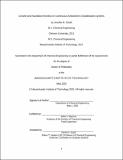Growth and nucleation kinetics in continuous antisolvent crystallization systems
Author(s)
Schall, Jennifer M.(Jennifer Moffitt)
Download1193319926-MIT.pdf (4.786Mb)
Other Contributors
Massachusetts Institute of Technology. Department of Chemical Engineering.
Advisor
Allan S. Myerson.
Terms of use
Metadata
Show full item recordAbstract
Continuous pharmaceutical manufacturing can provide multiple advantages over batch processing: enhanced process control, more consistent final product quality, increased productivity using smaller equipment, and the ability to maintain smaller chemical inventories. More specifically, the multi-stage mixed-segment, mixed-product removal (MSMPR) process represents a robust, continuous process that will enable us to manufacture products with acceptable yield while meeting constraints on crystal size distribution (CSD), polymorphism, and purity. This thesis considers both the thermodynamic and kinetic effects of solvent composition on continuous MSMPR combined cooling and antisolvent crystallization (CCAC) cascades, detailing where common crystallization assumptions fail and suggesting ways to improve continuous CCAC process design in the future. We successfully validated solvent-dependent growth and nucleation kinetic models to rationally design a multi-stage, continuous, combined cooling/antisolvent crystallization process for an industrially-relevant drug. Our work demonstrates that solvent effects must be incorporated in kinetic expressions for proper antisolvent MSMPR crystallization cascade design, as solvent composition effects may dominate temperature and residence time effects. In general, neglecting solvent-dependent kinetics tends to result in over-predicted yield and mean particle size at high solvent volume fractions and under-predicted yields at low solvent volume fractions. Our work also demonstrates that failing to incorporate activity coefficient-dependent supersaturation estimates leads to not only substantial errors in supersaturation calculations, but also large errors in predicting growth and nucleation kinetics, crystallization yields, and crystal size distributions. Finally, we investigated conditions under which transitioning from batch to continuous manufacturing is financially advantageous. Together, our findings provide a framework for future continuous antisolvent crystallization process development and design.
Description
Thesis: Ph. D., Massachusetts Institute of Technology, Department of Chemical Engineering, May, 2019 Cataloged from the official PDF of thesis. Includes bibliographical references (pages 137-144).
Date issued
2019Department
Massachusetts Institute of Technology. Department of Chemical EngineeringPublisher
Massachusetts Institute of Technology
Keywords
Chemical Engineering.